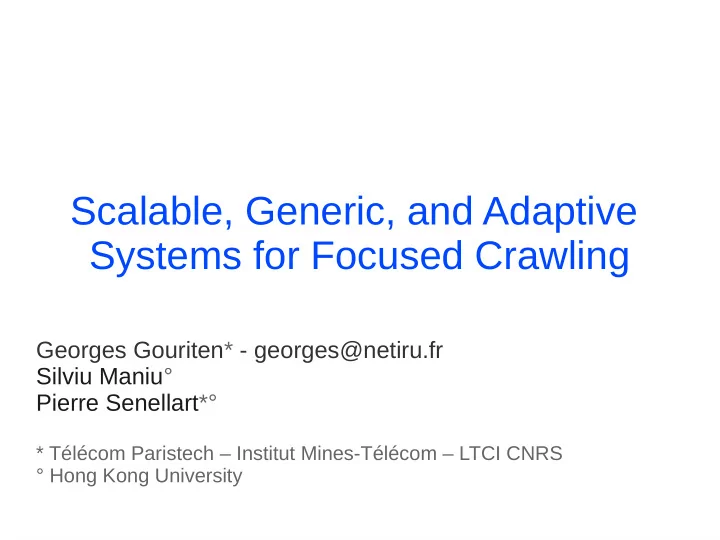

Scalable, Generic, and Adaptive Systems for Focused Crawling Georges Gouriten* - georges@netiru.fr Silviu Maniu° Pierre Senellart*° * Télécom Paristech – Institut Mines-Télécom – LTCI CNRS ° Hong Kong University
What is focused crawling?
A directed graph
Web Social network P2P etc.
Weighted 5 3 0 2 5 0 0 4 3 3 3 2 4
Let u be a node, β(u) = count of the word Bhutan in all the tweets of u
Even more weighted 0 0 2 0 3 0 1 0 1 0 0 0 0 0 1 3
Let ( u , v ) be an edge, α(u) = count of the word Bhutan in all the tweets of u mentioning v
The total graph 0 5 5 0 3 3 0 0 2 0 3 0 2 2 5 5 0 0 1 0 1 0 0 0 0 0 4 4 0 3 3 0 3 3 3 3 1 3 2 2 4 4
A seed list 0 5 5 0 3 3 0 0 2 0 3 0 2 2 5 5 0 0 1 0 1 0 0 0 0 0 4 4 0 3 3 0 3 3 3 3 1 3 2 2 4 4
The frontier 0 5 5 0 3 3 0 0 2 0 3 0 2 2 5 5 0 0 1 0 1 0 0 0 0 0 4 4 0 3 3 0 3 3 3 3 1 3 2 2 4 4
Crawling one node 0 5 5 0 3 3 0 0 2 0 3 0 2 2 5 5 0 0 1 0 1 0 0 0 0 0 4 4 0 3 3 0 3 3 3 3 1 3 2 2 4 4
A crawl sequence Let V 0 be the seed list, a set of nodes, a crawl sequence, starting from V 0 , is { v i , v i in frontier(V 0 U {v 0 , v 1 , .. , v i-1 }) }
Goal of a focused crawler Produce crawl sequences with global scores (sum) as high as possible
A high-level algorithm Estimate scores at the frontier Pick a node from the frontier Crawl the node
Supposing a perfect estimator
Finding an optimal crawl sequence offline: NP-hard Greedy wins for a crawled graph > 1000 nodes Refresh rate of 1 is better
Estimation in practice
Different kinds of estimators
bfs 5 3 0 2 5 0 0 4 3 3 3 2 4
bfs 5 3 0 2 5 0 0 4 3 3 3 2 4
bfs
nr navigational rank score propagation from the ancestors of a node then to the children of a node
nr
opic online page importance computation ~ online pageRank computation
opic 2. ->
Open spaces in the state-of-the-art nr has a quadratic complexity opic focus on popularity the rest is about how to score
First-level neighboorhood
Second-level neighboorhood
Neighborhood-based estimators
deg, e, n, ne deg: number of neighbors e: sum of incoming edges n: sum of incoming nodes ne: sum of incoming (node*edge)s
Linear regressions
Multi-armed bandits (1) slot slot slot slot machine machine machine machine 1 2 3 4 ...
Multi-armed bandits (2) Budget n, how to maximize the reward? Balance exploration and exploitation
Applied to focused crawling Slot machines: estimators Reward: score of the top node
mab_ε probability 1-ε: slot machine with the highest average reward probability ε: random slot machine
mab_ε-first steps [0, └ ε x N ┘ ]: random slot machine steps [ └ ε x N ┘ +1, N]: slot machine with the highest average reward
mab_var Succession of ε-first strategies, with a reset every r steps, r varying with the context
Their running times
Expected running times Twitter API for one week: - 3s - 200,000 nodes One domain website for one week: - 1s - 600,000 nodes
Experimental framework (1)
Experimental framework (2) ─ Graph score 10 seed graphs 1 seed graph: 50 seeds picked randomly among non-zero β Arithmetic average of the crawl scores (sum) ─ Global score Normalization with a baseline -- relative score Geometric average among the five graphs
Datasets and code are online http://netiru.fr/research/14fc
To measure the running times Same crawl sequence: the oracle Storage in RAM (20G) 3.6 GHz
The running times (ms)
nr Quadratic complexity, with large constant factors
Their precision
The precision Same crawl sequence: the oracle Precision: distance of the top node to the actual top node Arithmetically averaged over a window of 1000 steps
For bretagne
Their ability to lead crawls
Leading the crawl Different crawl sequences: defined by the top estimated nodes
Average graph scores for France
The multi armed-bandits
All the estimators
Conclusion
What we learnt Generic model NP-hardness offline Refresh rate of 1 Greedy Neighborhood features Linear regressions Multi-armed bandit strategy
Future work Approximation of the optimal score Distributed crawl Recrawling nodes Further multi-armed bandits comparisons
Thank you. georges@netiru.fr
Finding the optimal crawl sequences in a known graph
PTime many-one reduction from the LST-Graph problem Problem remains hard if nodes, not edges, are weighted A subtree rooted at r is seen as a crawl sequence starting from r Free edges are added to the graph to allow free crawls from he seed to any potential root of a subtree
Rich friends will make you richer
The greedy strategy Node picked = argmax(β(v)), v in frontier
Is not always optimal 12 3 20 4 1 2 2
The altered greedy strategy Node picked = probability q: argmax(β(v)) probability 1-q: random v so that, max(β(u)) - β(v) <= ζ x max(β(u))
Altered greedy vs greedy for jazz
The refresh rate disadvantage
When estimation takes too long
The score degradation (%) at different steps
Recommend
More recommend